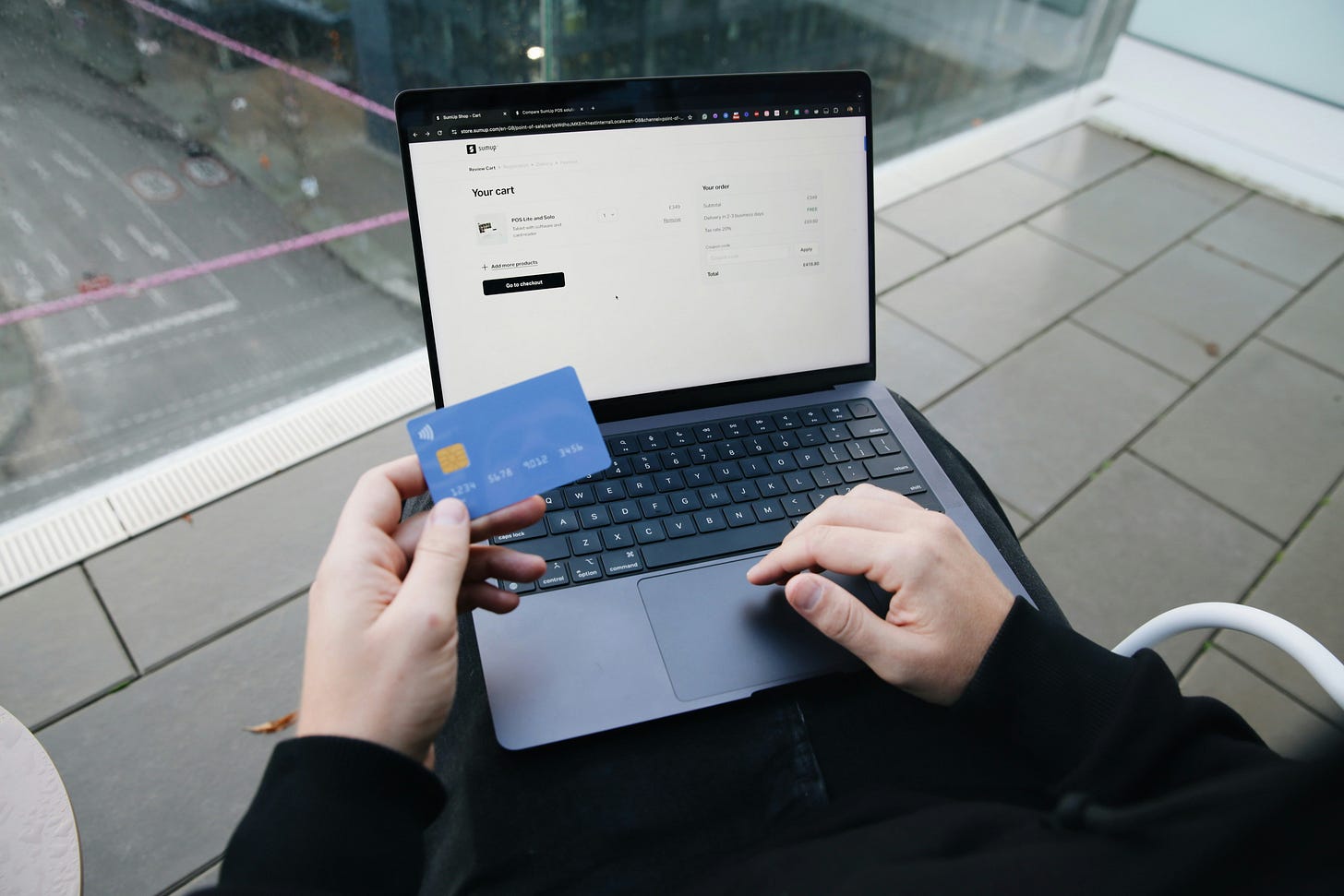BNPL For SMEs: How To Find Product Fit
Given the saturation of products of offer within SME lending, how can a B2B buy-now-pay-later solution stand out as a viable solution?

In this series of articles, I am examining the business case for B2B buy-now-pay-later. Specifically, the pricing, product fit and go-to-market required to provide a profitable BNPL B2B offering.
This is part two, where I'll be taking a look at Product Fit.
Earlier, we looked at BNPL pricing for B2B and the ingredients required to run a successful and profitable product. Now let’s move our attention to Product Fit. It is important to remember that positioning any B2B BNPL solution should consider the pricing design and limitations set out in article one.
I am also referencing BNPL here in its purest and most identifiable form - keeping payments interest free for the buyer. Many BNPL players have now evolved to including longer-term and interest based instalment plans for customers (which can make good sense), but these fringe features are not included within scope of this article.
B2B BNPL Remains A Real Growth Sector
Since I wrote my last article on BNPL, there remains upbeat news for SME lending innovators: B2B Buy Now Pay Later is still witnessing significant growth. According to recent estimates, the global market had been projected to reach USD $199.2 billion by the end of 2024 and shows no signs of slowing in 2025.
Thanks to rising inflation and a high interest rate environment, SMEs are seeking more alternatives to business financing.
That said, product fit remains a serious undertaking within the competitive and complex environment of business lending. Join me as I explore product elements of B2B BNPL’s Flexibility & Accessibility, and Competitiveness.
Flexibility & Accessibility
Online Checkouts
In late 2023, Affirm struck gold with its partnership alongside Amazon Business, to support its SME customers (sole-traders) with BNPL options.
Affirm, who started life as a B2C BNPL offering, took the challenge to expand their offering to SMEs. As I highlighted in an earlier article, Should Consumer Lenders Migrate Towards SMEs?, expanding finance offerings to include businesses is no easy feat. The first step for B2C lenders should be to begin with sole-traders, which is exactly what Affirm chose to do.
A significant factor to the success of buy-now-pay-later can be found in its ability to embed itself at the point of sale. B2C shopping chart experiences had been digital for years prior to the rollout of BNPL, therefore adopting a ‘pay in 4’ feature was a natural evolution for most.
Similar to B2C, within B2B, the ‘easiest’ route for BNPL will also be through embedding itself into online checkout environments.
It’s not uncommon these days, especially on B2C shopping sites, to be faced with a ‘Christmas tree’ of colours and purchase financing options. Sellers care about selling, and from my experience, the general belief from merchants is the more ‘financing choice’ available to their customers, the better.
For those entering the B2B BNPL at online checkout, it will be key to make strategic plays, as in Affirm’s Amazon example, that secure exclusive rights to take the upper hand.
The Invoice Sales Cycle
And while $18 trillion (USD) flows through global B2B online checkouts each year (enough to keep BNPL providers happy), that number is dwarfed by $131 trillion which flows through B2B invoicing.
B2B buy-now-pay-later providers who want a share of this £131 trillion yearly pie have more of a challenge on their hands. Providing BNPL within the invoicing payment experience can be challenging and opens up lenders to more operational risk and administration.
Let’s break down the four main components of the buying experience via B2B invoicing and where BNPL integration should occur:
Ordering - the point of time where the buyer (after being satisfied with a sales quote) instructs the seller they wish to proceed with the order.
During the sales process the seller should (ideally) have made the buyer aware of BNPL options, resulting in the sale or a larger volume of sale (more about this in my next article). The buyer can at this point go away separately to complete an application with the BNPL lender before committing to a total order value.
This can be a space where sellers get nervous about BNPL. Unlike B2C lending, B2B underwriting is more complex and in most circumstances it just takes longer. The last thing a seller wants is to slow down their sale due to a pending BNPL application with the buyer and lender. Thankfully for BNPL, B2B underwriting is getting faster, and could even be accelerated via AI in years to come (I’m due to write an article on this soon).
Payment - in many settings, when the seller issues an invoice to the buyer, they are notified of the ‘payment terms’. This could be a real mixture, including an upfront deposit requirement (e.g., if the seller needs to make or order parts in advance), or a 30, 60 or even 90 day window to pay the invoice.
Payment terms are the enemy of BNPL in B2B lending (since the buyer has an agreed ‘interest free’ window to repay the invoice). Terms however, are subjective on the buyer / seller relationship, including level of trust and capacity to repay (and whether or not the competition down the road are offering more generous trading terms). If the seller is not willing to offer payment terms, i.e., requires the payment upfront, this is exactly where BNPL can strike.
Buy-now-pay-later enders who can embed themselves in to the B2B invoice or payment experience e.g., links within digital invoices with easy to follow application instructions, will have the most chance of success (see my next article on B2B BNPL go-to-market).
Delivery - in many cases, the supplier will arrange to deliver goods to the buyer. Before or after invoice payment (see above).
For most lenders involved in the B2B buying and delivery process, it is crucial to confirm delivery of goods from the buyer (via receipt of delivery) before making payment to the seller. This adds operational overhead, but as a lender it reduces your risk to be involved in disputes between the buyer and seller.
Competition

As a general rule, the longer SMEs continue to trade and grow revenue, the more likely their relationship with one or more banks (or alternative lenders) will expand. This includes leveraging a variety of lending products to support its working cashflow and longer term investments.
It is difficult for any alternative BNPL lender to go head-to-head with traditional banks on price. Winning SME customers who already have deep relationships with banks and subsequently access to cheaper capital can be challenging, but not impossible.
Types of SME Lending
Before we jump in understanding the direct products in competition with BNPL, let’s first explore the general types of lending pathways offered to SMEs by bank incumbents (this is a non-exhaustive list):
Unsecured Lending - also known as ‘cashflow lending’ which is short term in nature and designed to match working capital cycles (12 months or less). Although most lenders will take a GSD (general security deed) over the business, this type of lending does not include ‘security’ (e.g., property or asset). Deemed ‘higher risk’ for lenders and is therefore pricing is higher.
Secured Lending - long term in nature (12 months or more), but can include working capital purpose lending (usually a customer will offer up security for working capital facilities to secure a cheaper rate). Most common form of security will include residential or commercial property.
Asset Lending - generally provided as a term loan facility (12 months or more) that is tightly linked to the purchase of an asset (e.g., machinery). The term repayment will be designed to accommodate the asset’s depreciation. Can also include forms of leasing finance (usually within working capital needs, 12 months or less).
Property Finance - lending specific to commercial and residential property developers and management houses. Unlike business secured lending, revenue comes from development revenue (e.g., pre-sales) or rental & lease income.
Trade Finance - lending that is closely tied to the import / export purchase cycle. Lenders remain hands on during the buying process and require proof of shipping and delivery stages (e.g., bill of lading) before finance is released.
Mezzanine Finance - lending that is a hybrid of debt and equity, often used for growth or acquisitions. Can be expensive due to risk but offers SMEs more flexibility without significant equity dilution. Usually long term in nature and can involve complex elements like subordinated loans or convertible debt facilities.
Invoice Finance - short term financing based on the businesses invoices receivable (financing based on a single invoice or multiple invoices within a facility ‘limit’), this form of financing includes two main approaches: invoice discounting (private) and invoice factoring (disclosed).
Within this myriad of financing solutions, there is some potential ‘competition’ to BNPL, or at least products with a various degrees of ‘overlap’ which we will explore in more detail.
The BNPL Advantage
As discussed in article one, given the nature of B2B BNPL pricing and the immense saturation already available to SMEs, it is important that any BNPL offering stay true to its most popular feature…
Staying interest free.
This benefit (and limitation) immediately puts BNPL firmly in the unsecured short term or ‘working capital’ bracket listed above, and to some degree, invoice discounting and factoring. As I mentioned in the last article, due to the need to charge merchants a discount, it's not often you see any pure BNPL ‘interest free’ solution allowing customers to pay longer than 90 days (without great expense to the seller).
BNPL vs Existing SME Lending Products
With this in mind and within the SME financing approaches listed above, we will now double click in to short term lending and the existing products which can overlap or be used as a substitute in BNPL’s product space. I have also included where I believe BNPL can position itself against these products as a suitable alternative:
Overdrafts / Revolving Credit Facilities
Usually supplied by banks and financial institutions as an unsecured (or sometimes secured) revolving credit facility capped at an agreed limit.
These facilities, which are interest charging, are very accessible and can be used easily for a SME’s working capital day-to-day, e.g., buying stock and inventory.
BNPL advantages over Overdrafts
Interest within a revolving facility is usually calculated daily and charged monthly to SMEs.
Interest rates can be expensive for overdrafts, especially if unsecured.
Since overdrafts are usually attached to a business’s current account (which includes day to day transactions) it can be difficult to distinguish single purchases within a revolving facility.
Credit Cards
A physical or virtual card supplied by financial institutions with a scheme provider (e.g., Visa, Mastercard or American Express).
Simple and convenient ease of use as the card acts as both a credit facility and payment vehicle all in one.
BNPL advantages over Credit Cards
Business Credit Cards are known for having expensive interest rates (on borrowings not paid back within monthly card statement balance).
Some suppliers or wholesalers do not offer credit card payment options.
Short Term Loans
Usually long term in nature, however can be provided as short as 3 months via alternative SME lenders (usually unsecured).
Designed for larger credit amounts and multiple use cases.
Allows for a set repayment plan and upfront factor rate.
BNPL advantages over Term Loans
Short term loans can be expensive, especially in the short term and usually contain administration fees.
BNPL is better suited for single purchases or invoices, whereas term loans should ideally be used for multiple cashflow needs.
Merchant Cash Advances
A loan facility that can be repaid from a set percentage of daily sales. Repayments therefore can be very flexible to ‘rise and fall’ in line with revenue.
BNPL advantages over MCAs
MCAs require some degree of admin to setup including new a new bank account where revenue, controlled by the lender, must be directed to.
MCAs can include significant administration fees and high factor rate charges (based on SME underwriting risk).
Invoice Discounting
A set facility limit that can be drawn down upon based on invoices raised. Provides businesses with invoice funds upfront (up to 80% in most circumstances) and customers are responsible for invoice credit control.
BNPL advantages over Invoice Discounting
ID is usually suited towards larger SMEs generating frequently and larger invoices. Requires initial setup time, hands on engagement with lender for monitoring and audit purposes.
Invoice Factoring
Like invoice discounting but when the lender takes ownership of collecting the payment. Designed for smaller SMEs and is usually done ‘invoice by invoice’ or i.e., the lender purchases the issued invoice from the SME.
BNPL advantages over Invoice Factoring
Due to the lender taking care of collecting payments, SMEs lose privacy of their lender arrangement with Factoring which can impact customer relationships. Designed for smaller SMEs and is usually done ‘invoice by invoice’ or i.e., the lender purchases the issued invoice from the SME.
Stay tuned for my next and final article in this B2B BNPL series where I will be exploring go-to-market considerations.
Enjoyed what you’ve read? Please subscribe for free to receive new SME Credit posts. Please leave a comment and consider sharing this article with your networks.




